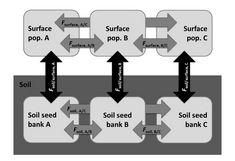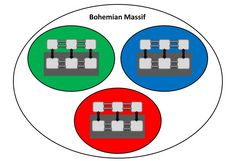Project description
-

Fig. 1: Schematic representation of spatial and temporal separation of populations (A, B, C) of ephemeral plants with a persistent soil seed bank. -

Fig. 2: Schematic representation of the hierarchical design of the study: large ellipse, Bohemian Massif region in Central Europe; small ellipses, different disturbance/management regimes (stochastic, irregular, regular) within the Bohemian Massif region; within small ellipses, spatial and temporal separation of surface population and soil seed bank. -

Fig. 3: Schematic representation of the hierarchical design of the study: large ellipses, different geographic regions in Europe.
Objective 1 was to study the distribution of neutral genetic variation within and between the soil seed bank and the yearly surface population at study sites with different disturbance/management regimes in relation to total genetic variation in the species, with following hypotheses:
- Hypothesis 1.1—The persistent soil seed bank functions as a "genetic memory", because it stores genotypes from earlier generations.
We take genetic differentiation between soil seed bank and surface population (Fsoil/surface in Fig. 1) as evidence that selection of best adapted genotypes out of the soil seed bank plays a role in the establishment of the surface population. On the other hand, if surface individuals are drawn randomly from the soil seed bank, Fsoil/surface should not deviate significantly from ought. Our central question, therefore, was whether the genetic composition of the actual surface population is different from that of the soil seed bank. - Hypothesis 1.2—Disturbance increases genetic variation.
If genetic variation enables species to survive in the ephemeral, semi-aquatic habitats with a high incidence of disturbance, we expect to find a correlation between intensity of disturbance/management (water level fluctuations in river habitats and charging/discharging of traditionally managed fishponds) and genetic variation within populations. Thus, populations of river habitats with a highly stochastic disturbance regime should have higher genetic variation than populations of fishponds with a more regular management regime. Populations of fishponds should thus represent a subset of the genetic variation harbored at river habitats. We tested this hypothesis in the Bohemian Massif region in Central Europe (Fig. 2). - Hypothesis 1.3—Many of the Isoëto-Nanojuncetea plant species occur sporadically throughout Europe – for short periods of time and at different points in time – meaning that populations are isolated spatially and temporally from each other. The question therefore arises whether there is genetic coherence or differentiation across a larger geographic area.
The primary habitats of ephemeral, semi-aquatic plants – riverbanks and bayous – should be connected by unidirectional propagation of diaspores by water flow within river systems (hydrochorous dispersal). Gene flow among primary and secondary sites could also come about through zoochorous dispersal of diaspores (e.g., by waterfowl or management measures, such as fish transport). Our question, therefore, was whether populations are genetically differentiated due to the action of drift and/or selection and lack of gene flow among sites (high FST values among geographic regions; Fig. 3) or whether populations of distant sites are genetically similar due to high levels of gene flow (low FST values among geographic regions). In regions, where Cyperus fuscus was seldom historically (e.g., in the Třeboň basin in South Bohemia), present populations could have been introduced by transport of fish
Objective 2 was to study variation and plasticity in quantitative traits associated with fitness as opposed to neutral genetic variation, with following hypotheses:
- Hypothesis 2.1—Adaptation processes in local populations lead to locally adapted phenotypes.
To test this hypothesis, we estimated whether populations are differentiated in quantitative traits associated with fitness (e.g., speed of germination, biomass, number of culms with inflorescences). In an environmental manipulation experiment, we measured fitness and growth traits on individual plants derived from the soil seed bank and surface population. We excluded effects of the parental generation by growing the mother plants that produced the seeds for the experiment under equal conditions in the same environment. - Hypothesis 2.2—Ephemeral, semi-aquatic plants have adapted to natural water level fluctuations and irregular discharge of pond water through increased phenotypic plasticity.
We assessed the contribution of provenance, environment (water level), and their interaction to the observed variation in quantitative traits. We thus asked what the amount of phenotypic plasticity in the soil seed bank and surface population of sites with different disturbance/management regime is. To assess phenotypic plasticity, we applied three different water treatments in the environmental manipulation experiment.


